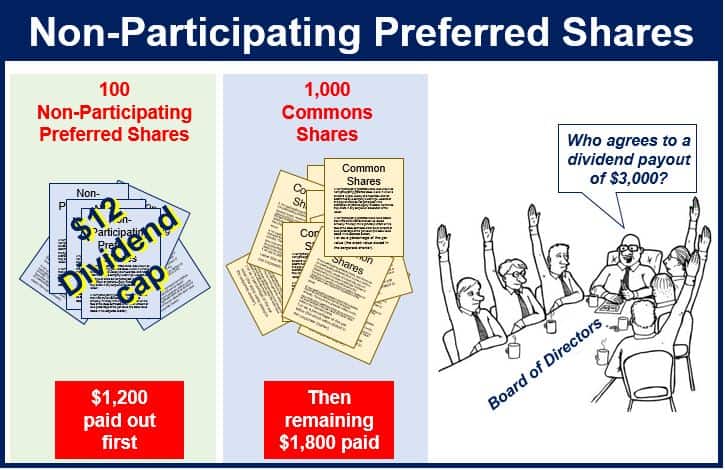A non-participating preferred share, also known as non-participating preferred stock, is one in which a dividend is paid, usually at a fixed rate, and not determined by a company’s earnings. Holders of this type of share do not participate in the distribution of profits to equity investors.
A non-participating preferred share has a feature that limits the dividends that can be issued annually. This top limit is generally written on the face of the stock certificate either as an amount or as a percentage of the par value (the stock value stated in the corporate charter).
All preferred shareholders get paid their dividends before any common shareholders. Even if the company has a bad year, it still has to pay the dividend to preferred stockholders. Common stockholders are paid with whatever money is left over, if there is any, after paying preferred stockholders their dividends.
 All preferred stockholders are paid before common shareholders get their money.
All preferred stockholders are paid before common shareholders get their money.
Non-participating preferred shares have a limit on how much can be issued annually to protect holders of common stock. If there were no limit, preferred shareholders might end up with all the dividend issued every year, which would be unfair for the common stockholders.
Participating preferred shares, however, get their standard dividend first and then receive a percentage of dividends that common shareholders receive.
Example of a non-participating preferred share
Imagine a company issued 1,000 common shares outstanding and 100 non-participating preferred shares. Each non-participating preferred share has a maximum-stated dividend of $12.
The board of directors declares a dividend of $3000.
The preferred shareholders receive $1,200 in dividends first. Then the common stockholders get the other $1,800.
If they were participating preferred shares instead of non-participating ones, their holders would receive the guaranteed $1,200 plus a percentage of the remaining $1,800 that is given to the common shareholders.
The main advantage of being a preferred shareholder is that you get your money first. Over the long-term, however, experts say that common stocks tend to perform better.
What if a company is sold?
If a company is sold, participating preferred stockholders get all their money back and then participate pro rata in the rest of the payout with the common stockholders.
A non-participating preferred shareholder has the choice of either getting all of his or her money back plus any accrued dividends, or participating pro rata with the holders of common stock.
The OECD says the following about non-participating preferred shares:
“These are a type of preferred shares in which the payment of a “dividend” (usually at a fixed rate) is calculated according to a predetermined formula and not determined by the earnings of the issuer. In other words, the investor does not participate in the distribution of profits to equity investors (if any), nor share in any surplus on dissolution of the issuer.”
